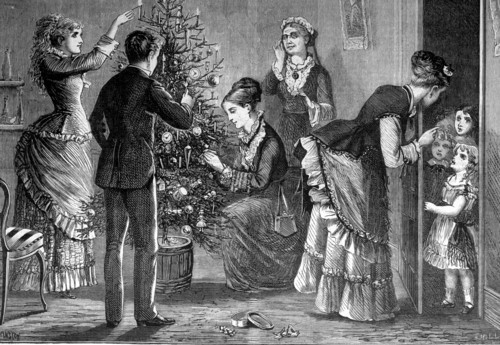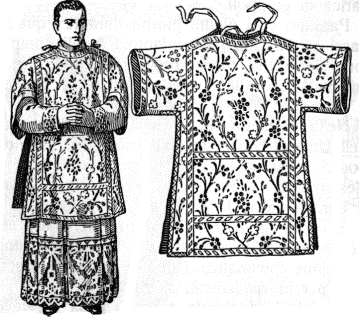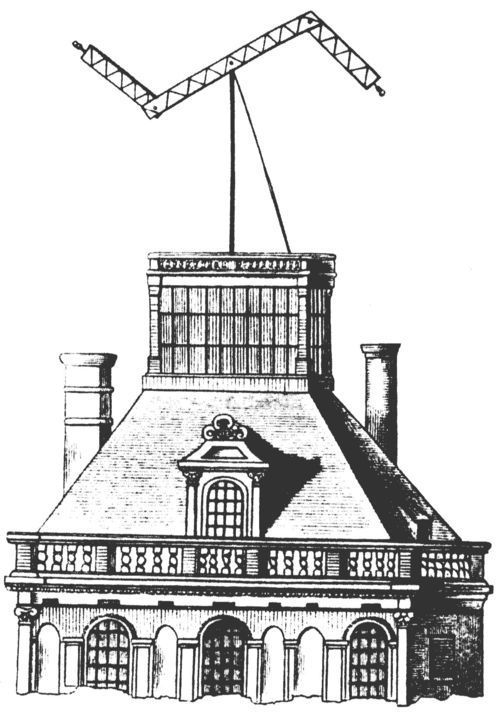Notice
The staff of the Low Churchman’s Guide would like to wish our readers a tastefully restrained Christmas and a New Year free of prolix ritual and ostentatious ceremonial.
The staff of the Low Churchman’s Guide would like to wish our readers a tastefully restrained Christmas and a New Year free of prolix ritual and ostentatious ceremonial.
Parts of the Mass: Eastward Celebration, Introits, The Last Gospel, Minor Propers, The Peace
Other Liturgical Services: Choral Evensong, Compline, Midnight Masses and Vigils, Processions, “Solemn” Things
Liturgical Year: Advent, Ember Days, Octaves, Septuagesima, Sexagesima
Vestments: Amices, Chasuble, Copes, Dalmatics and Tunicles, Maniples, Wearing Cassocks
Headgear: Birettas, Canterbury Cap, Mitres
Footwear: Organ Shoes
Architecture: Narthices, Reredoses, Rood Screens, Stained Glass
Liturgical Objects: Aspersoria, Bells, Candles, Incense, Monstrances, Sedilias
Decorations: Altar Flowers, Liturgical Colours
Support Staff: Armed Vergers, Masters of Ceremonies, Religious Communities, Subdeacons, Surpliced Choirs, Thurifers
Library Essentials: English Hymnal, Ritual Notes
Composers: William Byrd, Herbert Howells, Palestrina, Victoria, Healey Willan
Scholarly Endeavours: Gregorian Chant, Latin, Mixing Liturgical Books, Obscure Books, Patristics, The Sarum Use
Christmastide Customs: Christmas Eve, Christmas Ornaments, Lessons and Carols, O Antiphons
Pious Practices: Addressing Priests as Father, Genuflection, Oracular Confession, Rosaries
Other Cultural Practices: Complicated Weddings, Gin, Satire, Swimming the Tiber
Administrative: Hiati, Notice (again), Tearful Farewells
ale, ginger, diet, suitability for consumption with tomato aspic: Octaves
Anglicanism, individuals responsible for destruction of: Masters of Ceremonies
Antipas, Our Lady of: Patristics
apparel, bathing, impractical: Swimming the Tiber
artwork, sacred - assessed market value of, as basis for order of incensation: Thurifers
attendants, strangely dressed, screaming: Swimming the Tiber
battle, ritual, as means of advancement in acolyte guild: Masters of Ceremonies
baubles, Romish: Christmas Ornaments
bells, Sanctus - tintinnabular delights of: Healey Willan
beverages, spilled on bishops - disciplinary measures appertaining thereto: Dalmatics and Tunicles
black - saying, while doing the red: Victoria
boots, sturdy, worn with business suit, smart, by Fathers, Church: Patristics
businesses, local, insignia of, as decorations on vestments: Amices
cancer, common causes of: Incense
capabilities, nuclear, likelihood that Ritualists may be developing: Aspersoria
ceremonial, ostentatious, undesirability of in conjunction with ritual, prolix: Notice
chamfering, hiltronic: Eastward Celebration
churchmen, loyal - poorly written misrepresentations of: Satire
churchmen, loyal - punctilious and methodical publication habits of: Hiati
churchmen, loyal, missile attacks upon - role of rosaries in: Rosaries
closets, broom, use in storing surplus clergy: Sedilias
dephlogistication, anaerobic, as warning sign of pharyngeoskeletal complications: Genuflection
eel, electric, as official fish of liturgical season: Advent
faces, seemingly innocent, of young church musicians - concealment of grim papal visage thereunder: Organ Shoes
flum: see tuft
foliage, verdant, used to hide images of the Pope: Altar Flowers
fungus, massive, as metaphor for Ritualism: Christmas Eve
glurge: see whilf
graves, watery: Swimming the Tiber
harvests, saffron, firstfruits of, appropriate measuring instruments: Mitres
Heathen, Lesser - Conditional Rebaptism of: William Byrd
hermits, nineteenth-century, one-eyed, as translators of Portuguese psalm commentaries: Obscure Books
Hoadly, Bishop, devotional value of sermons: Choral Evensong
homes, roamed in by buffalo, requested by Ritualists: O Antiphons
lettuce, histories of, writing - use as penance: Oracular Confession
Lichen, Our Lady of: “Solemn” Things
limbs, artificial, not to be tolerated as accessory to choir dress: Wearing Cassocks
lungs, incense-blackened: Gin
mâché, papier- : Dalmatics and Tunicles
maniples, black, rite of: Liturgical Colours
Martinmas: Christmas Eve, Liturgical Colours, Midnight Masses and Vigils, Obscure Books, Septuagesima
Masses, Requiem, said for souls of parishioners with unsatisfactory tithing records: Liturgical Colours
Matins, Said, and Commination, commended as suitable Christmastide service: Lessons and Carols
medievalists, dyspeptic, and palaeographers, scrofulous: Sarum Rite
meetings, with parish priest, discussing his crypto-Romanist tendencies - general ineffectiveness of: Armed Vergers
monks, dyspeptic, and abbots, scrofulous: Sarum Use
neckties, setting fire to - penitential benefits of: Sexagesima
Pittsburgh, Our Lady of: Reredoses
pom-pom: see glurge
posts, blog, reading on home computers - appropriate liturgical garments: Copes
priests, lawless gangs of: Compline
Ritualists, gin-swilling, rosary-clutching, warning signs that one may be surrounded by: Addressing Priests as Father
Ritualist worship - grim and joyless character of: Minor Propers
Ritualist worship - irresponsibly hedonistic character of: Minor Propers
St Alphege, relics of - sale at coffee hour: The Peace
St Alphonus - patronage of elbow pads: Christmas Ornaments
St Bridget, hymns to, by Palestrina: Surpliced Choirs
St Christopher - patronage of pterodactyls: Stained Glass
St Enodoc, anticipated Solemn Sext of (transferred): “Solemn” Things
St Fulgentius of Ruspe, relics, tranferral of - Commemorations: Octaves
St Gondulph of Maastricht - patronage of dead languages: Latin
St Januarius, Conditional Rebaptism of the Oblates of: Complicated Weddings
St Januarius, invoked to send plagues of rickets against loyal churchmen: Palestrina
St Lucy, detached eyeballs of: Narthices
SS Perpetua and Felicity, invoked to prevent entanglement in one’s vestments: Amices
St Philibert of Jumieges, dubious nature of cultus: Processions
St Samson of Dol, merits, supererogatory, four: Ember Days
St Stephen - patronage of tinsel: Christmas Ornaments
St Ursula, Benediction of, with a Solemn Angelus: Complicated Weddings
St Wilgefortis: Christmas Ornaments
St Winifred, octave, second day of: Octaves
shoes, ill-fitting - effects upon Ritualist ceremonial practice: Introits
tongue, forked, and disloyal heart: Gin
Toronto, Ontario - Ritualist dive bars of: Healey Willan
towels, lavabo, amphibian entanglement: Copes, Introits
tuft: see pom-pom
Ulaanbaatar - as holy city of Ritualism: Eastward Celebration
vestments, subatomic inspection of: Dalmatics and Tunicles
Virgins, Seven, Requiem Dance of: Complicated Weddings
wails and yelps, blood-curdling: Choral Evensong
watercourses, famous, Italian: Swimming the Tiber
whilf: see flum

The editors of the Low Churchman’s Guide to the Solemn High Mass are sorry to announce the cessation of this informational series. Despite the importance of the Guide as a source of reliable and accurate information in a world besieged by Ritualism, the task of composing and fact-checking our articles has taken time away from more important tasks, such as picketing outside Ritualist churches and throwing rocks through stained-glass windows. It has further come to our attention that numerous social ills exist that do not fall under the direct purview of the Ritualist movement, a non-exhaustive list of which would include “dancing,” “fantasy novels,” “Velcro,” “automobiles,” and “flavoured vodka.” The retirement of this series will therefore allow our staff the freedom to protest against a greater variety of un-English and undignified modes of happiness.
In its short existence the Low Churchman’s Guide has exposed the dangers of organ shoes, narthices, Compline and other horrors to a generation apparently oblivious to their mortal danger. Critical acclaim for the Guide has been extensive, recognizing our writers for their “noxious attitudes” and “constant poking fun… a repeated revelation of his own ignorance and lack of understanding.” The many honours showered upon the Guide might tempt our staff to an attitude of unbecoming pride, but we remain true to the agenda that motivated its foundation in the first place: if even one person has been dissuaded from embarking upon a Ritualist career through reading our work, then the Guide has served its purpose. Such thoughts will provide reassurance and comfort as our editors embark upon new projects.
Although the Guide will no longer be updated, we are confident that the existing articles will provide materials of practical use to other low churchmen bewildered by the extent of Ritualist perversity. Its contents will also no doubt be useful to future generations of scholars attempting to trace the genesis and extent of the Ritualist phenomenon once it dies out, as it soon surely must. To aid these researchers in their efforts, the last official act of our staff will be to index our existing content under practical subject headings.
At this juncture it is traditional for an editor to extend a word of thanks to his readers for their invaluable service in making the publication a success. Loyal churchmen do not acknowledge the weight of tradition as having any determinative force, however, and in any case it is not clear why one should feel obligated to thank readers who contributed nothing toward the material support of this publication whatsoever. Our staff wrote all of the articles; you had only to read them. We hope that you will not send us letters of condolence or attempt to contact us in any manner; we do not plan to respond to any such messages.
The staff of the Low Churchman’s Guide would like to wish our readers a tastefully restrained Christmas and a New Year free of prolix ritual and ostentatious ceremonial.

In the early years of the Ritualist movement, the populace could protect itself from danger by the simple expedient of staying away from Ritualist places of worship. Pedestrians could be warned away from the infested area by a perimeter of police tape, which would serve to minimize any potential danger until the arrival of a team of specialist loyal churchmen with appropriate equipment. Because of the failure of the civil authorities to contain the Ritualist threat adequately, however, liturgical ornaments began to spread from the church precincts where they had originated, and to appear even in private homes. Arriving at the home of one of his co-workers for a Christmas party, the loyal churchman must remain constantly on his guard. If the house is full of devotional medallions, strings of beads and images of St Wilgefortis, there is no time to lose: the affected items must be removed in sealed bags for proper disposal and the home itself must be burned to the ground.
The task of tracing this infestation must ultimately be left to future generations of epidemiologists. We are concerned here merely with noting some of its most obvious and pernicious manifestations, especially the custom of decorating one’s home with Romish baubles during the later weeks of the Advent season. This custom has become so widespread in modern society that even many loyal churchmen have become inured to it, apparently unaware that by festooning their homes with “Christmas wreaths,” “Christmas trees” and “St Stephen’s tinsel” they risk lifelong damage to their health and a possible infection of the entire neighbourhood.
While the majority of “Christmas ornaments” are intended as decorations for the home, there are also particular garments associated with the process of Christmas decoration: because they are not worn during the celebration of the liturgy itself, it is generally assumed that these are paraliturgical vestments. The most popular such garments include the St Nicholas hat, St Rudolph antlers and St Alphonsus elbow pads.

A seasoned Ritualist is unfazed by situations that would terrify a normal Englishman. A loyal churchman would run for his life if he found himself in a dark stone building filled with poisonous smoke and flickering torches, surrounded by strangely-dressed attendants screaming at him in a foreign language, but among Ritualists this experience is known simply as “going up for communion.” The Ritualist does, however, have one Achilles’ heel, which is his inability to swim. One does not need to spend long in Ritualist circles before hearing of another hapless victim who has “swum the Tiber.” Such swimmers are spoken of in hushed tones and with a horrible finality: the departed Ritualist’s former friends commiserate with each other on what could have possessed him to take that fateful swim, describe how much they will miss him, and awkwardly change the subject. Although they never state this explicitly, it is clear what has happened; their former friend lies in a watery grave, and the Tiber has claimed another victim.
A loyal churchman, of course, would never actually visit Rome, and so we must rely on a copy of Baedeker’s for information on this famous Italian watercourse. Therein we search in vain for any mention of an undertow, swiftly-moving currents or poisonous jellyfish. Oceanographical authorities unite in describing the river as placid in movement, greenish in colour and unappetizing in smell; it is not clear why this specific body of water would exert such a fateful attraction to Ritualists. Even allowing for the Ritualist’s impractical bathing apparel, the fact that generation after generation loses their lives in the same foreign river with no apparent measures being taken to alleviate the problem would seem to point to an astonishingly high degree of incompetence.
Less frequently, Ritualist fatalities are associated with other bodies of water, such as the Bosphorus, the Elbe, Lac Léman, and the Great Salt Lake.

The dalmatic and tunicle are two vestments essentially identical in form but different in function, belonging to the appurtenances of “solemn” liturgical services. The dalmatic is worn by the deacon, while the tunicle is worn by the subdeacon. These terms, of course, are inexact, since the “subdeacon” is a mythological creature and the “deacon” is often not a true deacon but a fully-grown priest, ordered to serve in this menial role as punishment for spilling his drink on the bishop at a reception.
A matching set of tunicle, dalmatic and chasuble in a specific liturgical colour is known as a “high mass set.” Such a set may also include stoles and maniples made from the same fabric, but this is not strictly necessary, since if these items are required they can be made by members of the altar guild using papier-mâché. This is an important cost-saving measure for Ritualist parishes, since a high mass set requires special care and is extremely expensive: the replacement value of an antique high mass set often far exceeds the annual salary of the priests who will wear it. For this reason it is not uncommon for the vestry of a Ritualist parish to return newly-assigned priests to the diocesan offices for reassignment if their complexion and facial structure are ill-suited to the parish’s vestment collection.
Scientists have as yet been able to discover any difference between the dalmatic and the tunicle. This may indicate that the garments are in fact identical, or it may simply mean that the distinction between them is only observable at the subatomic level.

The repertoire of many Ritualist choirs includes musical compositions in the Latin tongue attributed simply to “Victoria.” The large and growing catalogue of works sold under the Victoria brand name includes the Missa O quam gloriosum, the Missa O magnum mysterium, the Missa Et ecce terrae motus and the Missa Dic nigrum fac rubrum. While the last-named of these is surprisingly catchy, the majority of these compositions are wholly without musical merit. It is thought that their performance in Ritualist worship constitutes a sort of elaborate inside joke, an interpretation that is supported by the occasional description of these works as “parody Masses.” But obtaining a printed copy of a “Victoria” composition only increases the confusion, since the music is printed not in correct English but in a sort of cipher using black dots and stems on a grid of horizontal and vertical lines.
Are these compositions written in a nigh-unbreakable code, or is this so-called “musical notation” a meaningless joke? Most loyal churchmen incline toward the latter opinion. Performances of the “Victoria” pieces vary too much from each other to be renditions of a stable and accurately notated original, and despite numerous hearings of these compositions our writers have been unable to detect a familiar hymn tune anywhere within the musical texture. It seems likely that the pitches of a “Victoria” composition are simply made up by singers on the spot. These performances also contain traditional improvised embellishments, such as the ringing of bells during the “Sanctus” and loud coughing during the “Agnus Dei”; these additions are typically in a different rhythm from the vocal parts and seem to be aleatoric in nature, suggesting that the “Victoria” phenomenon is influenced by the continental avant-garde.
For Ritualists to perform such musical compositions at all is already in poor taste, but for them to besmirch the name of the late Queen by associating her with these compositions is an unforgivable impiety.

The department of loyal churchmanship has received numerous congratulatory messages from readers of this publication, expressing their approval on the recent resumption of our publishing schedule after a six-month hiatus. This came as a considerable surprise to our editors, who were not aware that any such interruption of communications had taken place. Our investigation has revealed that all of the posts written for the Low Churchman’s Guide between June and December of the present year were intercepted and destroyed by Ritualist covert agents, perhaps using a special jamming device on their rosaries.
The loyal churchman cannot help but be struck by the injustice of the attitude displayed by our readers. If the Low Churchman’s Guide were edited by Ritualists, one might expect its publication schedule to be irregular and unpredictable, with new posts appearing according to its editors’ merest whims. But it is deeply unkind to interpret such capricious behaviour to loyal churchmen, who are known for the methodical, even punctilious approach they take to their publishing activities. That even seasoned readers of this publication would make such an elementary mistake is further proof, if any were needed, of the extent to which Ritualist propaganda has poisoned our civil discourse.